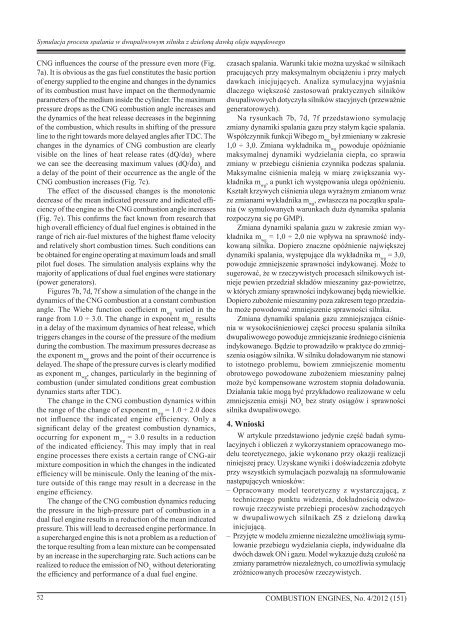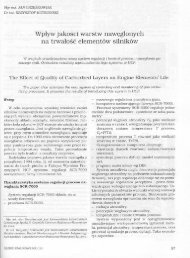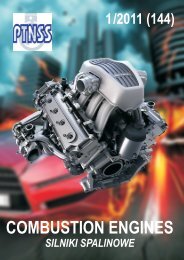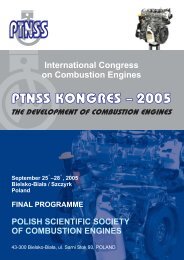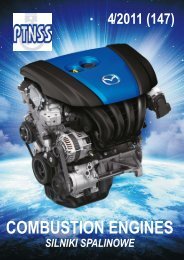You also want an ePaper? Increase the reach of your titles
YUMPU automatically turns print PDFs into web optimized ePapers that Google loves.
Symulacja procesu spalania w dwupaliwowym silniku z dzieloną dawką oleju napędowego<br />
CNG influences the course of the pressure even more (Fig.<br />
7a). It is obvious as the gas fuel constitutes the basic portion<br />
of energy supplied to the engine and changes in the dynamics<br />
of its combustion must have impact on the thermodynamic<br />
parameters of the medium inside the cylinder. The maximum<br />
pressure drops as the CNG combustion angle increases and<br />
the dynamics of the heat release decreases in the beginning<br />
of the combustion, which results in shifting of the pressure<br />
line to the right towards more delayed angles after TDC. The<br />
changes in the dynamics of CNG combustion are clearly<br />
visible on the lines of heat release rates (dQ/dα) g<br />
where<br />
we can see the decreasing maximum values (dQ/dα) g<br />
and<br />
a delay of the point of their occurrence as the angle of the<br />
CNG combustion increases (Fig. 7c).<br />
The effect of the discussed changes is the monotonic<br />
decrease of the mean indicated pressure and indicated efficiency<br />
of the engine as the CNG combustion angle increases<br />
(Fig. 7e). This confirms the fact known from research that<br />
high overall efficiency of dual fuel engines is obtained in the<br />
range of rich air-fuel mixtures of the highest flame velocity<br />
and relatively short combustion times. Such conditions can<br />
be obtained for engine operating at maximum loads and small<br />
pilot fuel doses. The simulation analysis explains why the<br />
majority of applications of dual fuel engines were stationary<br />
(power generators).<br />
Figures 7b, 7d, 7f show a simulation of the change in the<br />
dynamics of the CNG combustion at a constant combustion<br />
angle. The Wiebe function coefficient m wg<br />
varied in the<br />
range from 1.0 ÷ 3.0. The change in exponent m wg<br />
results<br />
in a delay of the maximum dynamics of heat release, which<br />
triggers changes in the course of the pressure of the medium<br />
during the combustion. The maximum pressures decrease as<br />
the exponent m wg<br />
grows and the point of their occurrence is<br />
delayed. The shape of the pressure curves is clearly modified<br />
as exponent m wg<br />
, changes, particularly in the beginning of<br />
combustion (under simulated conditions great combustion<br />
dynamics starts after TDC).<br />
The change in the CNG combustion dynamics within<br />
the range of the change of exponent m wg<br />
= 1.0 ÷ 2.0 does<br />
not influence the indicated engine efficiency. Only a<br />
significant delay of the greatest combustion dynamics,<br />
occurring for exponent m wg<br />
= 3.0 results in a reduction<br />
of the indicated efficiency. This may imply that in real<br />
engine processes there exists a certain range of CNG-air<br />
mixture composition in which the changes in the indicated<br />
efficiency will be miniscule. Only the leaning of the mixture<br />
outside of this range may result in a decrease in the<br />
engine efficiency.<br />
The change of the CNG combustion dynamics reducing<br />
the pressure in the high-pressure part of combustion in a<br />
dual fuel engine results in a reduction of the mean indicated<br />
pressure. This will lead to decreased engine performance. In<br />
a supercharged engine this is not a problem as a reduction of<br />
the torque resulting from a lean mixture can be compensated<br />
by an increase in the supercharging rate. Such actions can be<br />
realized to reduce the emission of NO x<br />
without deteriorating<br />
the efficiency and performance of a dual fuel engine.<br />
czasach spalania. Warunki takie można uzyskać w silnikach<br />
pracujących przy maksymalnym obciążeniu i przy małych<br />
dawkach inicjujących. Analiza symulacyjna wyjaśnia<br />
dlaczego większość zastosowań praktycznych silników<br />
dwupaliwowych dotyczyła silników stacyjnych (przeważnie<br />
generatorowych).<br />
Na rysunkach 7b, 7d, 7f przedstawiono symulację<br />
zmiany dynamiki spalania gazu przy stałym kącie spalania.<br />
Współczynnik funkcji Wibego m wg<br />
był zmieniany w zakresie<br />
1,0 ÷ 3,0. Zmiana wykładnika m wg<br />
powoduje opóźnianie<br />
maksymalnej dynamiki wydzielania ciepła, co sprawia<br />
zmiany w przebiegu ciśnienia czynnika podczas spalania.<br />
Maksymalne ciśnienia maleją w miarę zwiększania wykładnika<br />
m wg<br />
, a punkt ich występowania ulega opóźnieniu.<br />
Kształt krzywych ciśnienia ulega wyraźnym zmianom wraz<br />
ze zmianami wykładnika m wg<br />
, zwłaszcza na początku spalania<br />
(w symulowanych warunkach duża dynamika spalania<br />
rozpoczyna się po GMP).<br />
Zmiana dynamiki spalania gazu w zakresie zmian wykładnika<br />
m wg<br />
= 1,0 ÷ 2,0 nie wpływa na sprawność indykowaną<br />
silnika. Dopiero znaczne opóźnienie największej<br />
dynamiki spalania, występujące dla wykładnika m wg<br />
= 3,0,<br />
powoduje zmniejszenie sprawności indykowanej. Może to<br />
sugerować, że w rzeczywistych procesach silnikowych istnieje<br />
pewien przedział składów mieszaniny gaz-powietrze,<br />
w których zmiany sprawności indykowanej będą niewielkie.<br />
Dopiero zubożenie mieszaniny poza zakresem tego przedziału<br />
może powodować zmniejszenie sprawności silnika.<br />
Zmiana dynamiki spalania gazu zmniejszająca ciśnienia<br />
w wysokociśnieniowej części procesu spalania silnika<br />
dwupaliwowego powoduje zmniejszanie średniego ciśnienia<br />
indykowanego. Będzie to prowadziło w praktyce do zmniejszenia<br />
osiągów silnika. W silniku doładowanym nie stanowi<br />
to istotnego problemu, bowiem zmniejszenie momentu<br />
obrotowego powodowane zubożeniem mieszaniny palnej<br />
może być kompensowane wzrostem stopnia doładowania.<br />
Działania takie mogą być przykładowo realizowane w celu<br />
zmniejszenia emisji NO x<br />
bez straty osiągów i sprawności<br />
silnika dwupaliwowego.<br />
4. Wnioski<br />
W artykule przedstawiono jedynie część badań symulacyjnych<br />
i obliczeń z wykorzystaniem opracowanego modelu<br />
teoretycznego, jakie wykonano przy okazji realizacji<br />
niniejszej pracy. Uzyskane wyniki i doświadczenia zdobyte<br />
przy wszystkich symulacjach pozwalają na sformułowanie<br />
następujących wniosków:<br />
– Opracowany model teoretyczny z wystarczającą, z<br />
technicznego punktu widzenia, dokładnością odwzorowuje<br />
rzeczywiste przebiegi procesów zachodzących<br />
w dwupaliwowych silnikach ZS z dzieloną dawką<br />
inicjującą.<br />
– Przyjęte w modelu zmienne niezależne umożliwiają symulowanie<br />
przebiegu wydzielania ciepła, indywidualne dla<br />
dwóch dawek ON i gazu. Model wykazuje dużą czułość na<br />
zmiany parametrów niezależnych, co umożliwia symulację<br />
zróżnicowanych procesów rzeczywistych.<br />
52 <strong>COMBUSTION</strong> <strong>ENGINES</strong>, No. 4/2012 (151)


